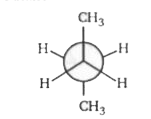Which of the following conformations of n-butane has a plane of symmetry?




The correct Answer is:A
To determine which conformations of n-butane have a plane of symmetry, we will analyze each conformation step by step.
1. Understanding n-Butane Structure:
- n-Butane (C4H10) consists of a straight chain of four carbon atoms. Each carbon is bonded to hydrogen atoms to satisfy the tetravalency of carbon.
2. Identifying the Conformations:
- The question provides four different conformations labeled A, B, C, and D. We will analyze each conformation to check for a plane of symmetry.
3. Analyzing Conformation A:
- In conformation A, we have:
- CH3 on one end, CH3 on the other end, and two hydrogen atoms in the middle.
- If we draw a plane that bisects the molecule between the two CH3 groups, we can see that each half is a mirror image of the other.
- Conclusion: Conformation A has a plane of symmetry.
4. Analyzing Conformation B:
- In conformation B, we have:
- Two hydrogen atoms on one carbon and two hydrogen atoms on the adjacent carbon.
- A plane can be drawn through the central carbon, splitting the molecule into two equal halves where each half reflects the other.
- Conclusion: Conformation B also has a plane of symmetry.
5. Analyzing Conformation C:
- In conformation C, we have:
- CH3, H, H on one side and CH3, H, H on the other side.
- There is no way to draw a plane that divides this structure into two equal halves that are mirror images of each other.
- Conclusion: Conformation C does not have a plane of symmetry.
6. Analyzing Conformation D:
- In conformation D, we have:
- CH3 on one side and CH3 on the other side, with hydrogen atoms in between.
- Similar to conformation C, there is no plane that can divide this structure into two equal halves that are mirror images.
- Conclusion: Conformation D does not have a plane of symmetry.
7. Final Answer:
- The conformations of n-butane that have a plane of symmetry are A and B.
- n-Butane (C4H10) consists of a straight chain of four carbon atoms. Each carbon is bonded to hydrogen atoms to satisfy the tetravalency of carbon.
- The question provides four different conformations labeled A, B, C, and D. We will analyze each conformation to check for a plane of symmetry.
- In conformation A, we have:
- CH3 on one end, CH3 on the other end, and two hydrogen atoms in the middle.
- If we draw a plane that bisects the molecule between the two CH3 groups, we can see that each half is a mirror image of the other.
- Conclusion: Conformation A has a plane of symmetry.
- In conformation B, we have:
- Two hydrogen atoms on one carbon and two hydrogen atoms on the adjacent carbon.
- A plane can be drawn through the central carbon, splitting the molecule into two equal halves where each half reflects the other.
- Conclusion: Conformation B also has a plane of symmetry.
- In conformation C, we have:
- CH3, H, H on one side and CH3, H, H on the other side.
- There is no way to draw a plane that divides this structure into two equal halves that are mirror images of each other.
- Conclusion: Conformation C does not have a plane of symmetry.
- In conformation D, we have:
- CH3 on one side and CH3 on the other side, with hydrogen atoms in between.
- Similar to conformation C, there is no plane that can divide this structure into two equal halves that are mirror images.
- Conclusion: Conformation D does not have a plane of symmetry.
- The conformations of n-butane that have a plane of symmetry are A and B.
Similar Questions
Knowledge Check
Which of the following conformation of n-butane has a center of symmetry?
A B
B C
C D
D
Which of the following conformations of butane is most stable?
ASkewBAntiCGaucheDEclipsedWhich is the lowest energy conformation of butane ?
A B
B C
C D
D
Which of the following is not an isomer of butanal?
View SolutionMost stable conformation of n-butane is :
View SolutionWhich of the following compounds does not contain the plane of symmetry ?
View SolutionWhich of the following compounds do not have the plane of symmetry?
View SolutionA line which bisects a compound in two equal parts and both parts appear to be the mirror image of each other, such kind of symmetry is known as plane of symmetry.
Any molecule that has a internal mirror plane of symmetry cannot be chiral, even though it may contain asymmetric carbon atoms.

Which of the following compounds does not contain plane of symmetry?
View Solution
